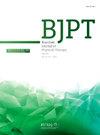Perceptions and beliefs of physical therapists regarding the mechanisms of manual therapy
IF 3.2
3区 医学
Q1 ORTHOPEDICS
引用次数: 0
Abstract
Background
Manual therapy (MT) is a widely utilized approach for managing musculoskeletal pain and functional disorders, particularly through joint mobilizations. Traditionally explained by immediate biomechanical processes, a paradigm shift has occurred in the last few decades, recognizing neurophysiological mechanisms as crucial contributors.
Objectives
To evaluate whether this shift is also reflected by clinicians, this study explores the beliefs and perceptions of physical therapists regarding the mechanisms underlying MT through an online survey design. The focus was if dominantly peripheral biomechanical model or a neurophysiological explanatory model prevails.
Methods
The study involved a national cross-sectional survey of 569 physical therapists, average age 36.5y (9.7), and 58 % female. Based on a fictitious case scenario, participants rated on a scale from 0 % to 100 %, the involvement of anatomical structures and physiological mechanisms and provided additional suggestions.
Results
The majority of responders attributed significant involvement to the brain (75 %), myofascial structures (71 %), peripheral nervous system (68 %), and cervical joints (60 %). Mechanisms such as endogenous pain modulation (73 %), placebo effects (72 %), muscle activity (68 %), and neuromuscular responses (62 %) were commonly endorsed. The data indicated that socio-demographic and work-related characteristics are weakly associated to specific beliefs, emphasizing the complex nature of these perspectives. The findings underscore the diversity in physical therapists' beliefs and highlight the importance of understanding the mechanisms, as they significantly contribute to the perceived effectiveness of MT.
Conclusion
This study provides valuable insights into the current landscape of beliefs among German physical therapists, contributing to the ongoing dialogue between basic research and clinical practice in MT.
物理治疗师对手工治疗机制的认知和信念
背景:手工疗法(MT)是一种广泛应用于管理肌肉骨骼疼痛和功能障碍的方法,特别是通过关节活动。传统上由直接的生物力学过程解释,在过去的几十年里发生了范式转变,认识到神经生理机制是关键的贡献者。为了评估临床医生是否也反映了这种转变,本研究通过在线调查设计探讨了物理治疗师对MT机制的信念和看法。焦点在于是否以外周生物力学模型或神经生理学解释模型为主。方法对全国569名物理治疗师进行横断面调查,平均年龄36.5岁(9.7岁),其中58%为女性。基于一个虚构的案例场景,参与者在0到100%的范围内对解剖结构和生理机制的参与进行评分,并提供额外的建议。结果大多数应答者认为主要受累于大脑(75%)、肌筋膜结构(71%)、周围神经系统(68%)和颈椎关节(60%)。内源性疼痛调节(73%)、安慰剂效应(72%)、肌肉活动(68%)和神经肌肉反应(62%)等机制被普遍认可。数据表明,社会人口统计学和工作相关特征与特定信念的关联较弱,强调了这些观点的复杂性。研究结果强调了物理治疗师信念的多样性,并强调了理解机制的重要性,因为它们显著地促进了MT的感知有效性。结论本研究为德国物理治疗师信念的现状提供了有价值的见解,促进了MT基础研究和临床实践之间的持续对话。
本文章由计算机程序翻译,如有差异,请以英文原文为准。
求助全文
约1分钟内获得全文
求助全文
来源期刊
CiteScore
6.10
自引率
8.80%
发文量
53
审稿时长
74 days
期刊介绍:
The Brazilian Journal of Physical Therapy (BJPT) is the official publication of the Brazilian Society of Physical Therapy Research and Graduate Studies (ABRAPG-Ft). It publishes original research articles on topics related to the areas of physical therapy and rehabilitation sciences, including clinical, basic or applied studies on the assessment, prevention, and treatment of movement disorders.

 求助内容:
求助内容: 应助结果提醒方式:
应助结果提醒方式:


